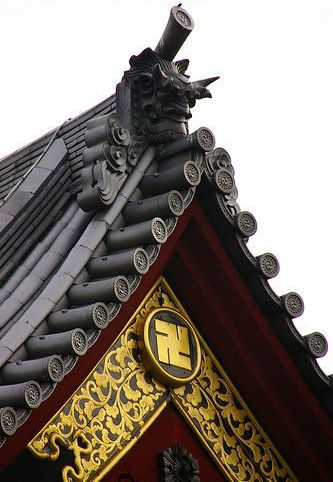Information about the origins of the swastika-shaped Han ideogram(s) is in script expert
Andrew West's blog.
António Martins-Tuválkin, 12 April 2006
Interesting; what he calls the "reverse" swastika is actually the variant used
in Asia for millennia. The "Nazi" version is really the historically reversed
design. But I guess we've come to take that as "normal", or at least
well-known, so the original design is now "reversed".
Albert S. Kirsch, 12 April 2006
This text merely calls it so in view of the fact that the "unreversed" version is called clockwise swastika.
This text explains, i.a., that both are just two variant forms of the same symbol: "was some disagreement amongst Chinese authorities as to which form was correct." (For good measure, both forms were encoded as separate characters: "卍" and "卐".)
Is it true that this "urban myth" was already definitively debunked (as in
our page where we discuss the Left-handed Swastika legend) but apparently not. Anyway, the article
we're commenting, written by an expert in east Asian scripts and
character encoding, states that both forms were used in China and
adjoining regions well before the Nazi usage (actually the text
hardly mentions this usage at all) -- see Hirosaki, Japan but the
war flag of Tsugaru Nobuhiro with different orientations,
or the Falun Gong
but the Jains.
António Martins-Tuválkin, 13, 16 April 2006
I can't speak of "exceptions", although the personal design of the Tsugaru
seems unusual in that regard. My experience there came from tourist maps all
over the place which showed Shinto shrines with a "torii" (archway) logo and
Buddhist temples with a swastika, uniformly of the lefty orientation. Best to
check with our Japanese members as to whether that is truly the more common
design or whether there is closer to a 50-50 mix.
Albert Kirsch, 17 April 2006
Actually, I find it highly unlikely that the Nazi swastika has anything at all to do with any other swastika to be found in non-western culture. Nazism has in its core an extreme form of racism and they would never adopt a symbol they would perceive as coming from an "impure" and "inferior" culture.
The Nazi swastika refers to the Roman and Greek swastikas, often used in decorations, usually as long rows of interconnected decorative elements, and to these alone. It's a claim on a symbol that they perceived to incorporate their ideals of classic "superiority" of a "pure race" (connected with the entry point in Europe of the Aryans, blah, blah, blah, the usual Nazi/neo-Nazi/white supremacist bunch of crap) and their ideal of a long-lasting empire.
So, we should stop seeing German swastikas in every single similar symbol other cultures have established for countless ages.
(We have in Portuguese a name for this kind of cross that is more
generic than "suástica": "cruz gamada". This refers to the shape of the
Greek letter gamma, which is the same as the arms of the cross - the
cross can be seen as consisting of 4 gammas. Does a similar term also
exist in English? If it does, then, it would be a better term to
apply to all those crosses that have nothing to do with the Nazi
swastika, despite sharing with it the same overall shape).
Jorge Candeias, 14 April 2006
Actually the very word "swastika" comes directly from Sanskrit (the regular German word is "Hakenkreuz"), and what is "impure" and "inferior" for 1933-1945 German Nazis is not necessarily the same for the comparatively ragtag outfits that today claim Nazi ideological ascendancy.
The "pure race" claim doesn't fit with Heidegger's ideas (and others who provided
additional inspirational) about
the virtues of the Classic civilizations. At Origins of the Swastika Flag (Third Reich, Germany) we
shown how much the choice of the swastika for the early NSDAP was an all
but fortuitous decision, the symbol being back then quite widespread and
devoid of a fixed meaning as the yin-yang is today.
António Martins-Tuválkin, 16 April 2006
Swastika is a Sanskrit word meaning "of good omen", from "svasti", safety.
Quite the opposite of the Nazi ideology.
Ivan Sache, 15 April 2006
There is 'fylfot', a Middle English word.
Jan Mertens, 14 April 2006
I have heard the term "gammadion" in English but am not sure how widely it is
used. There's also the German "hackenkreuz" (possibly misspelled) or
broken/twisted cross (possibly mistranslated as well.
Albert S. Kirsch, 14 April 2006
I would still suggest using "swastika", even though it may not be accurate. Most people know what a swastika is and/or looks like. Some even know that it has an existence outside Nazi Germany. But using another word might confuse some (and when you're explaining what that word is, invariably the word "swastika" will come up somewhere in your description.)
I thought that "swastika" was the pre-Nazi word for the generic-style cross as well, I'm sure that isn't a Nazi word (doesn't sound German enough).
I also think that the word used in cultures that still use it (mainly east Asian
ones) probably have their word translate to English as "swastika".
David Kendall, 14 April 2006
A fylfot is always left-handed and the arms are half-length. But it's
similar.
Albert S. Kirsch, 15 April 2006
There is unfortunately no easy and international answer to this problem. In France, "croix gammée" (lit., Gamma-shaped cross) refers to the Nazi cross - especially for the generations who have experienced the Second World War and the German occupation. It is advised to use "swastika" for the non-Nazi crosses of that kind, but the word is still mostly used in scholar and academic circles.
This means that mostly everybody presented with such a cross will call
it "croix gammée" and associates it to the Nazis, whatever the context
is. This can also be true for symbols which looks like it, such as the
Basque cross and the Breton triskel.
Ivan Sache, 15 April 2006


